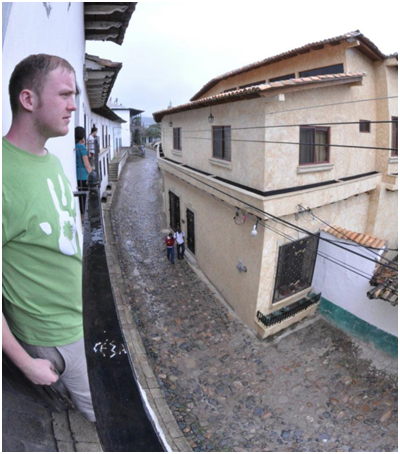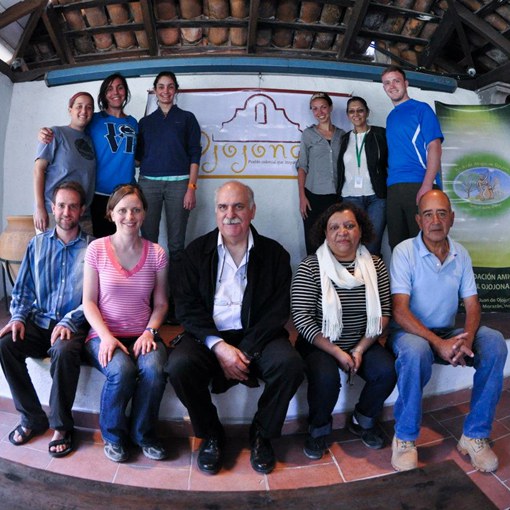Posted: June 13, 2012
Que Pedos?
Day 1
March 4th was a really interesting day. We had an awesome time traveling from State College to Newark (we all fell asleep quickly). We prepared to fly in Newark, NJ for Houston, Texas. It was a reasonably large plane, and we were mostly awake because of the sleep during the drive. We then transferred in Houston for a flight to Tegucigalpa. The flight there was almost as long, but the landing was entirely different. Ticontin international is one of the most dangerous airports in the world; the descent is steep and the runway is short. One we landed, it was time to journey to Zamorano.
Our driver was Renyeri and the professor who met us there was Ari. They were great individuals and they were a lot of fun. They took us to the University and gave us a tour of campus. The campus was huge and the climate was entirely different. Not only was it warm, but the campus was huge and completely different from Penn State. We were staying at the Kellogg Center at the University. Immediately after arrival, we were anxious to try some of the gorgeous fruit sold along the road. Not only was it pretty, but it tasted amazing. Fresh coconut and pineapple is simply irreplaceable.
Day 2
March 5th was an early day, we started off right at 6 AM for a trip to see a watershed and a local town. We started off with a breakfast in a little town and some locals explaining to us the history of their church. We then went right up into the mountains to see coffee farms and the beautiful watershed. Being "gringos," we were gawked at by many of the little kids in the nearby school on the mountain. They were playful, and we most certainly got some playtime in. On our way up the mountain to the very top of the watershed, we acquired two dogs. These two dogs quickly became my friends and we continued to stay together for most of the day. That journey to the top--a treacherous one--was full of mud and bumps. I am still not quite sure how we made it up the mountain.

When we left the mountain, we stopped once more to play with the children. I had boarded the Toyota with Erika, a Decea professor at Zamorano. She was wonderful and we had the best conversations about her time in the United States and her views on culture. On the return to Zamorano, we decided that it was time for some tree climbing. They had some absolutely gorgeous trees for climbing. Ari joined me briefly and we had a great conversation on how different the United States and Honduras really are. It was then I decided that I really like both Ari and Erika and had a lot to learn.
March 6thToday wasn't nearly as eventful early on. We woke up and went to Decea and started talking with two professors immediately, of course passing our favorite climbing tree. While there, we talked about the next couple days and what we would be doing. As we prepared to leave for the day, we also stopped and looked at a rather large wood collection.
Once we left, we were on our way to Yuscaran. There, we talked to the town historian about the history of the town and country. It was a rather interesting, but long, conversation about its colonial origins. We then went to a facility that produced aguar diente. The opportunity was provided to take a look at packaging, production, and shipping. Surprisingly, there were a large amount of bees all over the plant. I made sure to buy a little bit before I left.
From the aguar diente facility, we went to the local town museum in Yuscaran. The people had a large amount of pride in its colonial heritage. We had a great opportunity to learn about wealthy families and mining in the town. Once leaving, we went to eat at a local restaurant. There, we ate some more very salty food that was tough to chew, but we also left with dulces from a local woman.
After Yuscaran, we went to a pine resin production co-op. From the time that it was started, the co-op had grown immensely. The people working there had a large amount of pride in what they were doing. It was quite different to see how they were harvesting the resin and how they bonded together. As with the other projects, this was a project helped by Zamorano. Following the Pine Resin cooperative, we journeyed back down the mountain to head back to the University.
March 7th

Our early departure once again today resulted in a very different experience. Today's journey would take us to a shrimp production plant in the far south. The temperature was quite different, as it was much hotter and humid in the south. To those of us who were a little pale, the sun brought us distress later in the day.
We entered into a production facility that cleaned and packaged shrimp for North American grocery store chains. It was interesting to see how the company basically operated nearly everything for the employees. Groceries, very similar to the patch stores in coal towns, were even taken out of paychecks. I found this a little inappropriate and disgruntling. Although the plant was temporarily out of season, we had the opportunity to see the entire production facility.
After venturing through the shrimp plant, we went further south and out into the mangroves. The mangroves were absolutely beautiful and very interesting. We ran into several boats that were searching for oysters and were fishing with whatever they could find. It was sad to see how different the fishing industry was and to see how little they had, but they were continually trying to improve themselves.
March 8th
Not much to say today, we just had a good time in the south. We went back out onto the water and explored the south. We had a good day that was a little less packed than the others.
March 9th
Today rallied up my interest. We went to a town called Ojojona, a town funded by the benefactor Richard Vinelli. Richard was trying to install sewage in the town and bring water to the entire town. To a degree, he was quite successful. Much of the infrastructure had been built, it was just educating the people how to use it and how to pay for it. The residents didn't understand that they had to pay for both sewage and clean water, they thought that it would just come. This was the biggest obstacle to redeveloping the town.
This evening wrapped up very nicely. We had a campfire and dinner on top of a mountain. We also had a good hike that allowed us to see a cloud garden. It was beautiful and very dense. After dinner, we went to catch bugs near a pond. I had a blast seeing the bugs and catching them with a whole different group of people. I would say that this was one of the best nights on the trip.
March 10th
Home! What a long journey all the way back to State College from Tegucigalpa!
Ag Sciences Global
Address
106 Agricultural Administration BuildingUniversity Park, PA 16802
- Email globalag@psu.edu
- Office 814-863-0249
- Fax 814-865-3055
Ag Sciences Global
Address
106 Agricultural Administration BuildingUniversity Park, PA 16802
- Email globalag@psu.edu
- Office 814-863-0249
- Fax 814-865-3055


